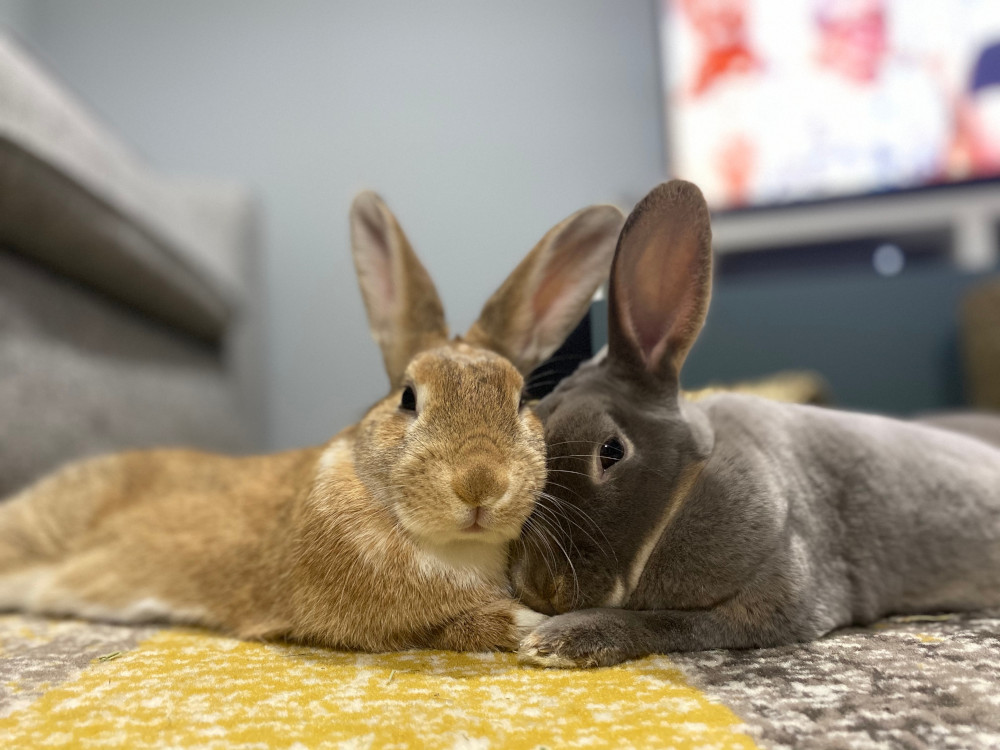
Rabbits are a social species and have evolved to live in groups. In the wild, rabbits do not live alone. Rabbits kept as companions are not biologically different from their wild counterparts and so their innate need to be kept in the company of other rabbits is just as strong. Rabbits have been shown to choose to spend time with other rabbits when they have the opportunity and, in fact, value the companionship of other rabbits as highly as food [1–3]. In addition, rabbits who are housed with another rabbit have fewer abnormal behaviours, such as fur chewing and bar biting [4–6].
Companion rabbits
Rabbits need the company of their own kind. No matter how hard we try, we cannot give our companion rabbits as much company as another rabbit can. We lead busy lives and even if we make sure we spend three or four hours a day with our rabbits, that means that they spend 20 hours or more without us. However, if they have at least one bonded partner rabbit they will never be lonely.
Rabbits are sociable, but they are also territorial. Therefore, rabbit introductions must be conducted carefully. Rabbits who are unknown to one another will need separate housing until they are successfully bonded. The process of encouraging rabbits to live compatibly with one another is called bonding, mixing, or pairing. This process takes time and effort, but it is essential to carry out the bonding process properly and with the rabbits’ welfare in mind. See our article on bonding here.
Once the rabbits have bonded, they should not be separated as this will cause significant distress and can severely damage the bond. Therefore, if one of bonded pair of rabbits needs to visit a veterinarian, then both should be taken, which will provide comfort for them both. Because rabbits form such powerful bonds with one another, the loss of a bonded companion can cause depression and illness. It is advisable to adopt another suitable rabbit as a friend if a loss means that a rabbit is left without a companion long-term.
Other companion species
Despite what many people believe, rabbits and guinea pigs should not be housed together. While there are some exceptions to this general rule, rabbit and guinea pigs do not usually get along and will often injure one another. In addition, the guinea pigs must be provided with areas where they can escape from the rabbit and must also be provided with Vitamin C daily as rabbits and Guinea pigs have very different requirements for vitamin C. Guinea pigs must have a dietary source of Vitamin C because (like humans), they cannot synthesise Vitamin C from other food substances. For more information on what to feed your Guinea pig, see this article.
No matter how friendly your dog or cat may be, they are a predator species. Rabbits, as a prey species, recognise this and having a dog or cat in the close proximity is extremely stressful to them. And as for your dog or cat, eventually their predator instincts may get the better of them, and a fatal attack on your rabbit can happen without warning. So even of everyone seems to be happy sharing the other’s company, it is best not to allow rabbits to mingle with dogs and cats.
Human companions
Rabbits can make amazing, affectionate, and social pets, often forming close bonds with their owners and enjoying their company. Like dogs, rabbits are very intelligent and can be trained to do tricks such as coming when called, or even jump through agility courses. They can be great house pets if you take the time to socialise them and learn about their basic body language. But there is a downside due to widespread unrealistic expectations by rabbit owners.
This expectation is that their pets should enjoy being handled. Some have been told by their friends, veterinarian, or social media to handle their pets regularly ‘to make them calmer and friendlier.’ But again, the rabbit is a prey species and thousands of years of evolutionary conditioning cannot be overcome easily. Many rabbits will run away or defend themselves against being picked up. A rabbit who does not accept being lifted or carried around is, after all, just behaving like a normal rabbit. It is important for people to recognise that regular handling is for the benefit of the owner, not the rabbit. Rather than insisting on regular handling, an appropriate range of tactile interactions – usually on the floor – will allow people to have a relaxed and happy relationship with their rabbits.
References
[1] Held SDE, Turner RJ, Wootton RJ (1995) Choices of laboratory rabbits for individual or group-housing. Appl Anim Behav Sci 46:81–91
[2] Huls W, Brooks D, Bean-Knudsen D (1991) Response of adult New Zealand white rabbits to enrichment objects and paired housing. Laboratory Animal Science 41:609–612
[3] Seaman SC, Waran NK, Mason G, D’Eath RB (2008) Animal economics: assessing the motivation of female laboratory rabbits to reach a platform, social contact and food. Anim Behav 75:31–42
[4] Podberscek AL, Blackshaw JK, Beattie AW (1991) The behaviour of group penned and individually caged laboratory rabbits. Appl Anim Behav Sci 28:353–363
[5] Lidfors L (1997) Behavioural effects of environmental enrichment for individually caged rabbits. Appl Anim Behav Sci 52:157–169
[6] Chu LR, Garner JP, Mench JA (2004) A behavioral comparison of New Zealand White rabbits (Oryctolagus cuniculus) housed individually or in pairs in conventional laboratory cages. Appl Anim Behav Sci 85:121–139
